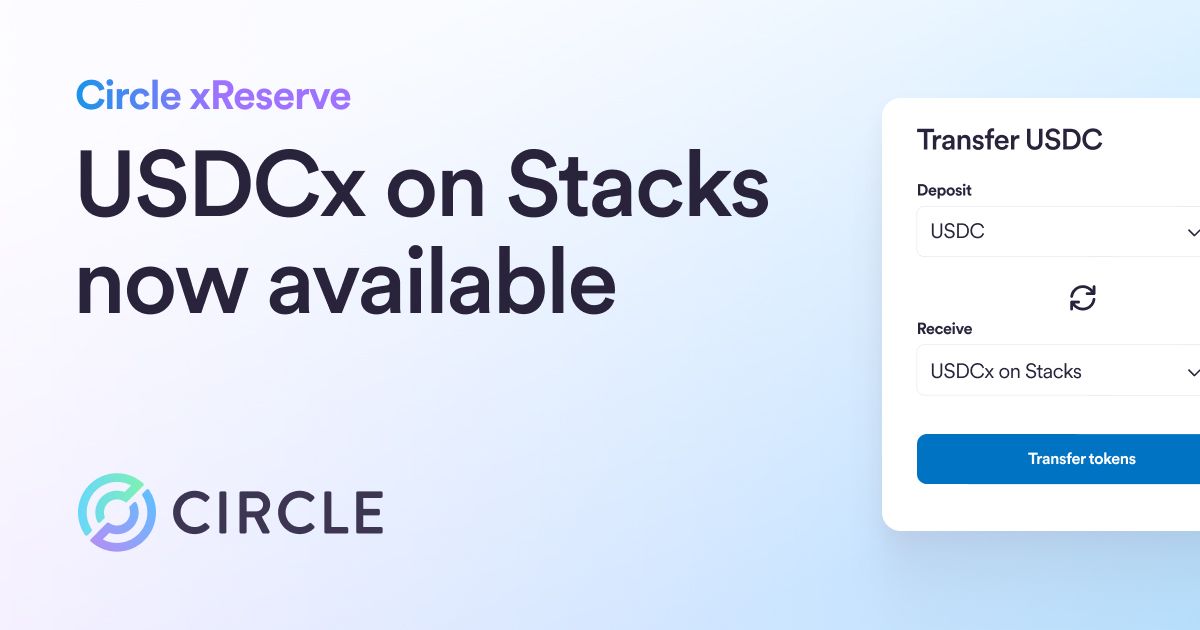Learn about how the US financial system can benefit from widespread adoption of digital dollar stablecoins.

BOSTON, January 5, 2021 — 2020 has been a watershed year for digital dollar stablecoins, such as USDC. The market capitalization of the stablecoin market exploded, increasing from around $6 billion to over $28 billion, highlighting the increasing adoption of digital dollars.
On episode 15 of The Money Movement, Circle CEO Jeremy Allaire talks about the implications of the rise of stablecoins and their benefits for the US financial system with Acting Head of the OCC at the US Treasury Department, Brian Brooks.
Unlocking the Potential of the Stablecoin Revolution
The tremendous rise in the use of stablecoins in 2020, coupled with increasing interest in cryptoassets as a whole, as evidenced by the recent surge in the price of bitcoin, has been matched by increasing movement on the regulatory front.
“We’re heading into a time when the leading financial regulators in the world have been working towards and setting regulatory policy around digital currency,” Jeremy explained.
“Likewise,” he added, “we’re seeing heightened interest and activity, especially from the largest fintechs in the world in this space. We are really in an incredibly exciting time around digital coins at this time.”
Brian Brooks, Acting Comptroller of the Office of the Comptroller of the Currency (OCC), who was a guest on episode 15 of The Money Movement, cited his experience with financial innovation while working at government sponsored mortgage lender Fannie Mae as opening his eyes to the power of technology to improve financial services.
While at the lender, he saw how the ability of financial apps to provide access to essentially all of a customer’s financial data without having to ask them for any documents presented the opportunity to significantly reduce the time it took to process a mortgage.
With regard to the potential of digital dollar stablecoins, Brian said that he sees the use of technology in the form of digital dollars as a way to help the dollar maintain its competitiveness in a changing world. While the dollar is currently considered the world’s reserve currency, Brian pointed out that this stems from historical circumstances arising after World War II, “but the world that we live in is not that world anymore.”
This trend has been demonstrated by global central banks reducing their dollar holdings and diversifying away from the dollar in recent years, he said. His view is that, in a world of competition, the dollar can benefit by being able to transact more attractively than other currencies. This is where he sees stablecoins and the blockchain as being able to play a role in helping to preserve the role of the dollar in the global financial system.
Jeremy cited the internet as using open, interoperable systems to take things that were slow and expensive to process and making them ubiquitous, open, and frictionless. An example of this can be seen in global communications, email for instance, which enables rapid, free communication globally.
He believes stablecoins can enable that same transition with global money.
An Inflection Point for Digital Currency Adoption
Brian sees this inflection point of the adoption of digital currency globally as being a development that doesn’t need to be built by government, given the country’s history of harnessing its strong market-oriented private sector to build such public goods.
"One way of thinking about where this goes is the idea that there are public goods that don’t necessarily have to be delivered by the government."
—Brian Brooks, Acting Head of the OCC at the US Treasury Department
He cited blockchain as a classic example of this phenomenon. Another example is the development in the US of decentralized banking from the 1860s as the US grew a network of privately owned national banks all across the country to provide a resilient, accessible banking system.
"My personal view is the ultimate public ownership of the payment rails is when you have a network of interconnected institutions and computers that are maintaining ledgers and allowing direct person to person transactions. The internet is the classic example of that. I think we are way down the path of decentralization. I think we are now maybe close to the point where we will achieve ultimate decentralization, but we’ve been on this journey for 200 years."
—Brian Brooks, Acting Head of the OCC at the US Treasury Department
Jeremy considers public blockchains to be — by definition — public goods, which exist for the whole world not just to move money but for numerous other applications as well.
“With public chains and things like stablecoins, we are starting to see that happen in a nascent way in the financial system here,” he said.
Balancing Regulation and Innovation
Brian believes that stablecoins should be fully reserved, such as USD Coin (USDC).
“One of the things I think that we in the regulatory community need to do is provide some clarity about the reserve and audit expectations for these kinds of projects,” he explained.
An analogy Brian cited is the use of prepaid debit cards as a money transmission instrument, where the goal would be to convince people that if they are trading with a stablecoin, they are no more likely to lose their money than if they were using a prepaid card with a well-known retailer.
Another basic issue that the community needs to be thinking about, according to Brian, are issues with customer identification, BSA (Bank Secrecy Act) and AML (Anti Money Laundering) regulations that have to be resolved and are being debated in the government currently.
“These issues must be taken seriously but you also have to take seriously the demand side case for direct person to person value transfer and balance those concerns to get to a place that has credibility with the public and credibility that it’s not principally being used for illicit purposes – I don’t think it is, but those are things you need to talk about.”
In the longer term, what he sees happening is, first of all, having an internet native payment instrument as being fairly inevitable.
"An internet native currency is one that is interoperable, allowing value to be exchanged across platforms rather than being limited to a single platform. Stablecoins fit the bill, as they can be transmitted across any platform that accepts them, enabling them to be sent freely across platforms like emails."
—Jeremy Allaire, CEO of Circle
They also are programmable, enabling scheduling of debt payments as one innovation, offering the potential of a world where you never have to write a check again.
Programmability and instant settlement are two game changing features of stablecoins, according to Brian.
“If you had a native payment system that could transact instantly, that’s always going to be better than the current system which has time delays, chargeback risks and that kind of thing. And the liquidity enhancement alone is a huge juice to the economy.”
Jeremy concurred, citing the advantages of third generation blockchains which offer the ability to settle a transaction in seconds with very high levels of security and with transaction costs approaching zero.
Internet Native Money and the Global Economy
“In a world of internet native money, of digital dollar stablecoins in many ways people all over the world can vote with their smartphone what type of economic system they want to participate in. They can download a digital wallet from an app store, and they can start sending and receiving stablecoins and digital currency in that way,” Jeremy said.
Jeremy believes that a lot of people in various places around the world will vote with their wallets to be part of the dollar economy. There are already formal and informal communities using dollars around the globe. “This phenomenon does have these geopolitical dimensions to it,” Jeremy said.
“You have China launching internet native money. You will have the ability for anyone with a digital wallet in the world theoretically to settle a transaction directly with the Peoples Bank of China, in their particular model, or perhaps settle it through another digital wallet app.”
He added that the ability for digital currency to exist where the internet exists does in some ways increase the competition for reserve currencies and how they are used in business around the world, making this not just a payments issue or efficiency issue but a geopolitical issue.
With regard to geopolitical competition in digital currencies, Brian stated: “the optimistic view would say it’s actually great that China is doing what they’re doing and that the private sector in the US is doing what we are doing. Because once you have stablecoins and markets can have more of an influence in which currency they select and which economic system they want to participate in, it will be harder for authoritarian regimes to prop up their currency as china has for years.”
He added: “It will be way easier for people to decide what that currency is really worth and to sort of bargain that down if that is the right thing. So bringing those market forces to bear has to be a good thing.”
Brian also cited the ability of stablecoins to cut costs on global transactions by eliminating the need to convert from one currency to one another as potentially boosting economic activity. With the dollar’s role as reserve currency under pressure, adding features that enable the currency to trade more efficiently is important “to envision a future where we’re being competitive as opposed to complacent.”
Stablecoins and the Future of Banking
Three to five years out, Brian said he sees banks as connecting to blockchains the same way they connect to SWIFT and ACH and other networks. “Once they do that, the nature of banking will begin to change.”
The reason for this, he said, is that, while he believes that banking will always be the key onramp and the key value add service provider for people’s financial services lives, banks will not be the bottleneck of transactions. Instead, they will be nodes on a network along with a lot of other nodes, many of which will not be banks.
“That will allow banks to focus on what they’re best at and what we really need them to do,” he said.
He added: “I do think that in a world of geopolitical instability, cryptoassets in general will grow and become a more significant part of people’s lives. It’s one of the reasons, I believe, that bitcoin prices are going up in a time of perceived instability.”
“Over time, the world tends towards more stability, things reach equilibrium. Since decentralized things are more stable than centralized things, I would predict that the movement that started 200 years ago with the First Bank of the United States, the movement towards more decentralization, will continue. Banks will add value to that and the world will go on, but in a cheaper, faster, more accessible way than it did before,” Brain explained.
“We are at an inflection point,” Jeremy said, “this rise of digital dollar stablecoins appear to be ready to cross the chasm from the early adopter phase and the disruptive innovator phase into more of the mainstream acceptance phase in the years to come.”




